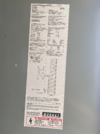I had a question regarding the 120% rule and if I have powerwalls does that make a difference? It seems that the gateway system is feeding 125A back into the main service panel, which is also receiving 200A from the main breaker. I've read that you'll need to downsize the main breaker otherwise the busbars can receive 200A+125A = 325A? Is that correct? Or is the backup gateway advanced enough to limit the amperage going to the main service panel?
Also, in the future when I need to add an ADU/extra circuits, can I add a 100A breaker to the main panel? Or does this also exceed the 120% rule? (100A for ADU subpanel + 125A for backup gateway connection = 225A.) I think my busbar is only 200A since I can't find any information on the panel indicating otherwise.
Unless I'm understanding it incorrectly. If I have two inverters and two powerwalls, the most kw I can supply back to the main panel is about 16kw which is 66amps. I can add a 100A breaker to the main panel without ever going over 120%.
Thanks!

Also, in the future when I need to add an ADU/extra circuits, can I add a 100A breaker to the main panel? Or does this also exceed the 120% rule? (100A for ADU subpanel + 125A for backup gateway connection = 225A.) I think my busbar is only 200A since I can't find any information on the panel indicating otherwise.
Unless I'm understanding it incorrectly. If I have two inverters and two powerwalls, the most kw I can supply back to the main panel is about 16kw which is 66amps. I can add a 100A breaker to the main panel without ever going over 120%.
Thanks!
Last edited:



